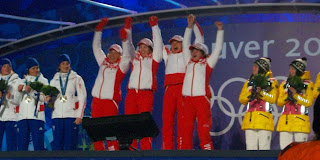I made the decision during my third and final week in Whistler, B.C. Since my internship at the 2010 Vancouver Olympic Games was with Cleanevent ― the company contracted to handle snow, cleaning, and waste removal at the mountain venues ― I deemed it only appropriate to educate myself to the greatest extent possible about the journey undertaken by the immense volume of waste generated at an event as substantial as the Olympics.
When I arrived at the Whistler Compost Facility I was under the impression that a tour had been prearranged for me by one of the Cleanevent managers. Although that turned out not to be the case, I was received warmly by Patrick Mulholland, the Compost Operations Manager, and immediately shown around anyhow.
Prior to committing to the site visit I had been warned by Cleanevent staff that “it smells really bad”. Apparently that is Australian for “you have never smelt a stronger, more foul odor in your life”. Upon entering into the compound, my senses were flooded by the aroma of baking biosolids and fermenting food waste. I tried to cough the smell out of my nose and lungs, but it stuck like the stench of a skunk’s spray on the hottest day of the year, so I sealed my nostrils tightly closed like a camel and resolved to breath solely through my mouth for the duration of the tour. The scent alone was enough to make me never want to generate any sort of waste ever again.
 |
| Pre-composted material, a mixture of food and biological waste, plus wood chips |
Patrick began our tour by explaining the special compost recipe they have been developing since the facility became operational; he spoke with complete ease and expertise, demonstrating that he was a true scientist and not just the friendly neighborhood trash collector. The proportions of the compost mixture have had to be readjusted and tweaked to produce the best results, but they currently stand at a ratio of 2,300 pounds of biosolids to 1,000 pounds of food waste to 3,000 – 5,000 pounds of wood chips. The correct balance is necessary in order to control the moisture, which needs to be at levels of 60% or below.
Another important factor to control before the process begins is the purity of the substances. Patrick explained that the compostable waste arriving from VANOC is considerably contaminated, and about 20% must be thrown out as garbage and enter the landfill instead. He showed me the section of the conveyer belt at which one of his employees must stand elbow-deep in waste, hand-picking out as much garbage as he can while it slides past. It was not in operation at the time of my visit, but I glanced around at the strapping young men buzzing busily about the complex and couldn’t help but wonder who the unlucky fellow was that got stuck on filter duty the most.
I had seen first-hand the waste management system employed by VANOC. They were not simply placing trash cans throughout the venues, but rather a small army of receptacles were clustered at each station consisting of: two compostable bins, clearly marked with green lids and a graphic illustrating what items qualified as compostable; one black bin for general waste, also labeled with a picture; and a Coke recycling barrel with a red lid whose opening was only big enough to fit a plastic bottle.
Early on, as the VANOC waste began to be collected and analyzed, the data showed that contamination was still high and that only about half of the waste was being diverted from landfills, rather than the goal of 85%. In an attempt to dummy-proof the system even more, Cleanevent employees at each venue created bigger signs, onto which they taped the actual items that belonged in each receptacle, making it even clearer that all the utensils, plates, and cups could in fact be composted, and that plastic wrappers could not.
 |
| Dummy-proof sign developed by Cleanevent staff |
The composting material continues to move slowly through the tunnels for a full fourteen days, while the crew monitors the temperature with probes and ensures proper ventilation. It is essential that enough oxygen can flow through so that CO2 is generated, not methane gas as is produced by landfills. At the midway point in the process, spinners break up the waste so that it does not become too compacted.
At the end of the two weeks all traces of that horrid, rotten smell have fled the compost and a clean, earthy odor has taken up residence in its place. The output is blended with sand to drain some excess moisture, and can then be sold as soil.
Although the selling of the soil allows for some cost-recovery, the facility is by no means self-sustaining. Just as utilities, the capital expenditure is huge for an operation like this. The revenue from soil sales, even along with the dumping fees and the average of $1,000 per week from tin can returns, can hardly make a dent in the costs of operations. The municipality recognizes the environmental benefit of diverting this waste from landfills, however, and that alliance permits the project to continue.
Though my employment foray in the waste industry was brief, the educational component was invaluable. I now recycle even more aggressively than before, and plan to have my own composting system once I have a housing situation that allows for it. I am also taking a pledge to support legislation that advocates for sustainable waste treatment. After all, there are a crew of guys in Whistler who tolerate a sickening stench day in and day out just to do their part in helping our Earth. Are you going to spit in their coffee?



















































